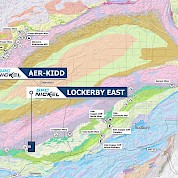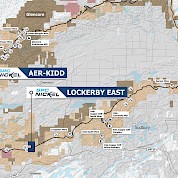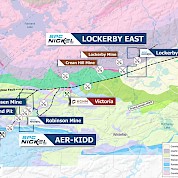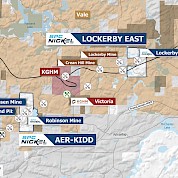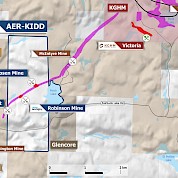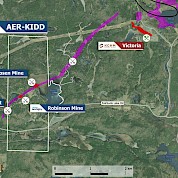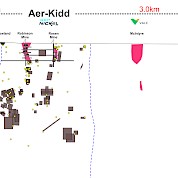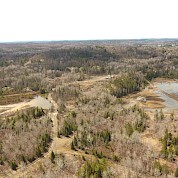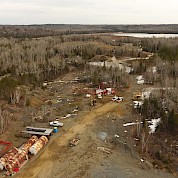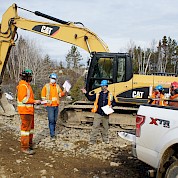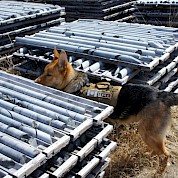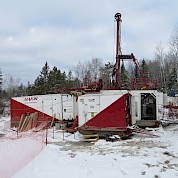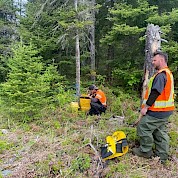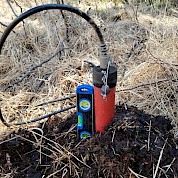Aer-Kidd Project, Ontario, Canada
Project Snapshot |
|
|---|---|
|
Status |
Exploration stage (Historical Past Producer – Early 1900s) |
|
Location |
35 km West of Sudbury, Ontario |
|
Commodity |
Nickel, copper, and platinum-group metals (PGM) |
|
Ownership |
4 Patents 100% Owned (Mining Rights Only), Option to purchase Surface Rights |
|
Current Exploration |
Compilation and analysis of historical and recent drilling. Target generation for new phase of work. |
|
Historic Resources |
|
-
Overview
The 272 hectare Aer-Kidd Property is located along the South Range of the Sudbury Impact Complex (SIC), approximately 35 km west of the City of Sudbury, Ontario. The property includes a ~1.5 km section of the mineralized Worthington Offset Dyke (WOD), which hosts KGHM’s Victoria Deposit (3.0 km to the northeast) and Vale’s Totten Mine (1.8 km to the southwest). Historical, production on the property during the 1950-1960’s came from a shallow open pit called the Howland Pit and two shallow underground mines called Robinson and Rosen. SPC Nickel has been actively exploring the property since 2014.
-
Project Presentation
-
Brief History
Mineralization was first identified on the Aer-Kidd Property in 1884 by Francis Crean who, along with Henry Totten, discovered mineralization along the western property boundary, later called the Howland Pit. In 1915-16, this deposit was mined from an open pit 75 ft in length, 30 ft wide and 80 ft deep with approximately 1,724 tons of ore grading 5.1% Ni and 2.1% Cu being produced.
The Robinson deposit was discovered in 1888 while the Rosen despot was discovered in 1891. In 1928, Denison Copper Mines Limited acquired the properties and completed a 20 hole, 12,000 ft drill program which resulted in an estimate of 741,240 tons grading 1.05% Cu and 0.81% Ni and $3.00 in precious metals per ton for the Robinson deposit. In January 1937, Denison Nickel Mines LTD. began sinking a 3 compartment vertical shaft on the Robinson Zone. This shaft was sunk to a depth of 980 ft, with stations cut at the 200, 350, 500, 650, 800 and 950 ft levels. The Company partially developed the top three levels, with most of the work done on the 500 ft level. The mine was closed in 1939 and the entire plant and buildings were subsequently sold. The development of both the Robinson and Rosen Mines as well as the 1,000 ton per day mill was finally completed in 1966, by Kidd Copper Mines LTD. Pre-production reserves in the Robinson Zone were estimated at 497,744 tons to the 800 ft level of proven and possible reserves grading 0.62% Ni and 0.71% Cu with a 10 % dilution. Reserves for the Rosen Zone were estimated at 274,560 tons of similar grade. Mining ceased in 1968 due to a fire and the property was abandoned in 1976.
In 2000 Crowflight Minerals (now CaNickel) optioned the property (mineral rights) and completed 48 holes for 26,850 meters over a four-year period. Borehole geophysics (BHEM) was done on some of the holes resulting in prospective conductive targets. Several holes successfully intersected mineralization. Highlights include: 1.42% Ni, 0.62% Cu, 1.75 g/t PGM over 8.91 meters at 844.16 meters in hole W03-03AW1.
In 2013 SPC Nickel Corp. (formerly Sudbury Platinum Corp.) purchased 100% interest in the mineral rights of the property. To date 63 holes have been drilled on site totaling 32,620 meters. BHEM surveys were done on most of the holes. Resulting geophysical anomalies correlate well with observed mineralization.
-
Geology and Mineralization
The WOD is one of several mineralized features of the SIC. The SIC is a large impact crater which melted the country rocks of the surrounding area. The resulting magma was injected into the country rocks though offset and concentric dykes. During the cooling period sulphides fractionated out of the magma and pooled into structural traps along the base of the crater, including offset and concentric dykes.
The Aer-Kidd Property is underlain by a succession of Precambrian pelitic metasediments belonging to the Huronian Supergroup that have been intruded by late Proterozoic dykes and sills of Nipissing-type diabase. Cross-cutting these lithologies is the NE-SW trending WOD that ranges in width from 30 to 75 m with an approximate 80⁰ SE dip. Late NW-SE trending olivine diabase and E-W trending quartz diabase dykes crosscut the property.
Along the length of the WOD several bends, pinches and swells are observed. These structures control the thickness and mineralization of the dyke. Such relationships are common for the SIC where embayments, bends, and folds of the basin act as structural traps for the fractionated sulfide rich magmas. Several bends, faults and pinches are modeled within the Aer-Kidd property where mineralization has been observed.
The WOD is composed of two distinct quartz diorite phases which are believed to represent separate magma pulses from the SIC basin. The primary phase is homogenous, contains trace to nil sulfides, and is commonly referred to as QD. The secondary phases is heterogenous, contains blebby sulfides pervasively, and is commonly referred to as IQD (inclusion rich QD). The inclusions within the IQD are representative of the country rocks in the area. Massive and semi-massive sulfides are most commonly observed within sections of IQD containing very large, rounded amphibolite fragments, referred to as amphibolite bearing IQD (AIQD). The AIQD zones appear to represent a trapping environment for sulphides within the central portion of the offset dyke. Sulphide mineralization typically occurs as either disseminated to blebby sulphide interstitial to the fragments or as massive to semi-massive sulphide stringers wrapping around larger amphibolite fragments. Four well developed zones of AIQD have been discovered on the property. From west to east they are called the Howland, Robinson, Rosen and the Perch Lake Trends. Drilling has confirmed that all four zones are mineralized to varying degrees and extend from surface to depth in excess of 1,500 m vertically.
-
Past Work
Since acquiring the property in 2013, SPC Nickel Corp. has completed 63 holes totaling 32,620 m. Highlights include:
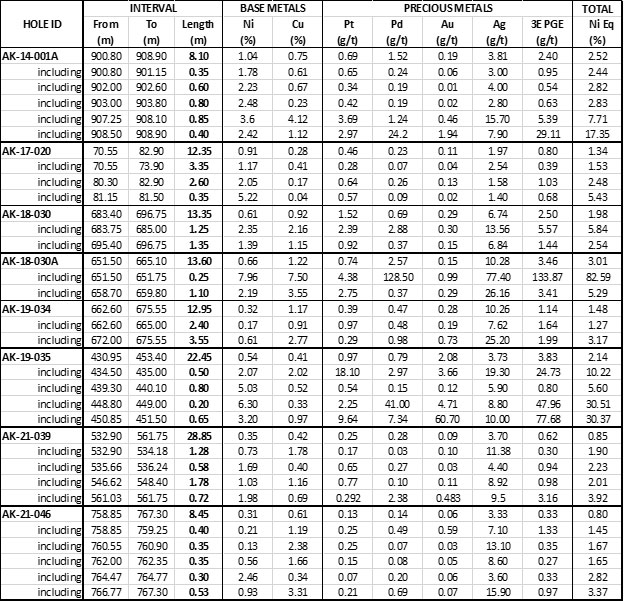
-
Maps and Figures
-
Photo Gallery
